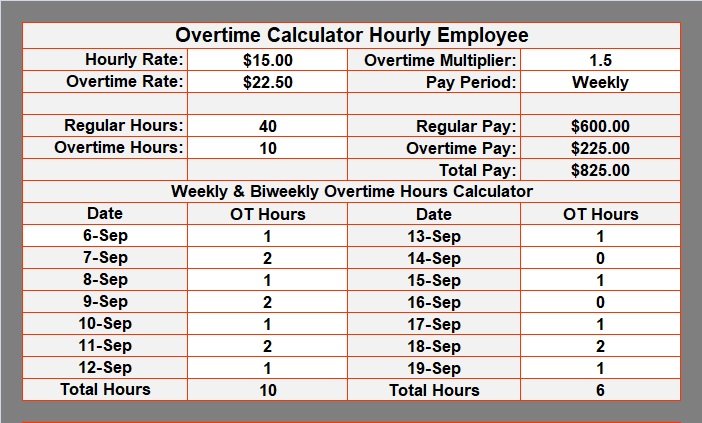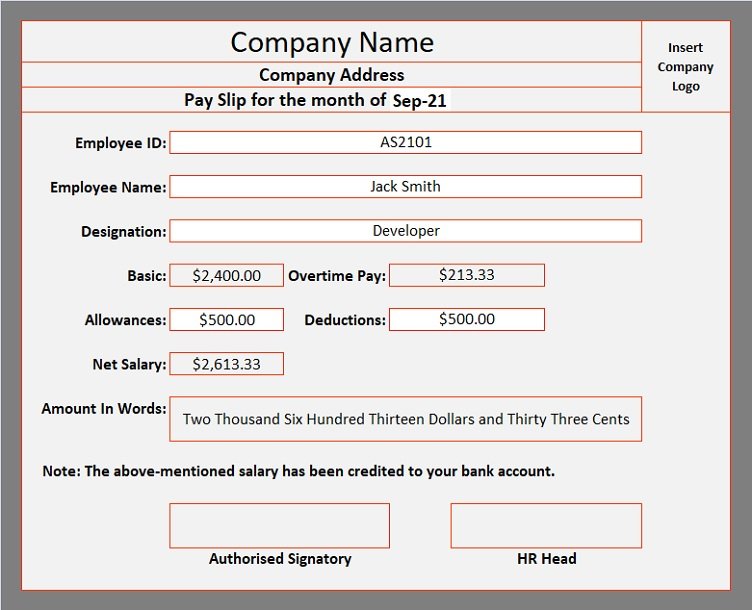Overtime Calculator Template with Payslip in Excel, OpenOffice Calc & Google Sheet to calculate overtime pay for hourly and salaried employees.
Moreover, this template helps you to calculate time and a half as well as double pay overtime. Additionally, you can print weekly, bi-weekly, and monthly payslips for employees with overtime.
Table of Contents
Download Overtime Calculator Template With Payslip (Excel, OpenOffice Calc & Google Sheet)
We have created a simple and easy Overtime Calculator Template with predefined formulas and functions. Just insert a few details and it will calculate the overtime for hourly as well as salaried employees.
Download your desired format and start using it.
Additionally, you can download other HR templates like Paycheck Calculator, Payroll Template With Attendance, Salary Slip Excel Template India, Simple Salary Sheet, and Employee Salary Sheet depending on the company requirement.
Moreover, you can download accounting templates like Sum of Years Depreciation Calculator, Straight-Line Depreciation Calculator, Declining Balance Depreciation Calculator, Profit & Loss Statement Template, and Balance Sheet Template, etc.
Feel free to contact us for the customization of this template as per your requirement. We also design new templates based on your needs. You can hire us for our services on Fiverr or directly contact us at info@msofficegeek.com.
What is Overtime Pay?
Overtime pay is the incremental amount that an employee pays to the employee for working additional hours in a workday or workweek.
The above definition applies to both hourly employees as well as salaried employees. Although the calculation methods differ for both.
In simple terms, overtime pay is the pay for working the excess of hours worked beyond the standard timings. Working overtime is very common and in some industries, it is even mandatory.
Generally, employees in construction, IT, manufacturing, etc industries often need to work overtime.
Governments design labor laws to prevent employees from being forced to work long overtime hours. Moreover, These laws and regulations define amicable compensation for overtime.
Overtime can be beneficial for both employee and employer. Employers get extra workforce recruiting extra staff.
Moreover, it saves the cost of training and managing new staff. Employees also get some extra income. Doing this is effortless because the activities performed are generally the same.
Overtime Rules
In general, most businesses follow the following rule: 8 hours a day and 40 hours per week. Anything exceeding this is overtime.
Employers define regular hours based on industry standards, employment contracts, etc. By law, these regular hours must follow national as well as state laws.
In the US, overtime is governed under the Fair Labor Standard Act (FLSA).
Highlights of Overtime Under Fair Labor Standards Act (FLSA)
- Unless exempt, employees covered by the Act must receive overtime pay for hours worked over 40 in a workweek at a rate not less than time and one-half their regular rates of pay.
- There is no limit in the Act on the number of hours employees aged 16 and older may work in any workweek.
- The Act does not require overtime pay for work on Saturdays, Sundays, holidays, or regular days of rest unless overtime is worked on such days.
- The Act applies on a workweek basis.
- An employee’s workweek is a fixed and regularly recurring period of 168 hours — seven consecutive 24-hour periods.
- It need not coincide with the calendar week but may begin on any day and at any hour of the day.
- Different workweeks may be established for different employees or groups of employees.
- Averaging of hours over two or more weeks is not permitted.
- Normally, overtime pay earned in a particular workweek must be paid on the regular payday for the pay period in which the wages were earned.
Source: US Department of Labor
Overtime Rate
The overtime rate is applicable on the basis of days and hours of the workweek. As per the law, there are two types of overtime rates: Time and Half and Double.
Time And A Half Overtime Rate
As the name says, it is 1.5 times the regular wage. F0r example if the regular pay rate of the employee is $25 per hour then his overtime rate per hour will be $25 X 1.5 = $37.50.
This overtime rate is applicable under the following:
- More than 8 hours in a day.
- More than 40 non-overtime hours in a workweek.
- Hours worked on the 7th consecutive day in a workweek.
Double Overtime Rate
Under this rate, the employee is paid double the rate. F0r example if the regular pay rate of the employee is $25 per hour then his overtime rate per hour will be $25 X 2 = $50.
This overtime rate is applicable under the following:
- More than 12 hours in a workday
- More than 8 hours on the 7th consecutive day in a workweek
Formula To Calculate Overtime for Hourly Employees
Overtime Pay = (Regular Rate X Overtime Rate Multiplier) X Overtime Hours
Where:
Regular Rate = General hourly rate.
Overtime Rate Multiplier = Time and half or Double
Overtime Hours = Additional hours worked above 8 hours per day or 40 hours per week.
Many industries have different work hours per day or week. It can be either be 9 or 10 hours per day or 48 – 50 hours per week.
Formula To Calculate Overtime Hours
Overtime Hours = Total Hours Worked – Regular hours (per day or per week)
Formula To Calculate Overtime for Salaried Employees
Follow the below-mentioned steps to calculate overtime pay for salaried employees:
Step 1
Calculation of overtime for salaried employees is different. First of all, to convert the monthly salary to per day salary divide it by 30 days.
Per Day Salary = Monthly Salary / 30 Days
Step 2
Now, divide per day salary by regular hours to get the regular hourly rate.
Regular Hourly Rate = Per Day Salary / Regular Hours
Step 3
Choose the multiplier and then multiply it with the regular hourly rate to get the overtime rate.
Overtime Rate = Overtime Multiplier X Regular Hourly Rate
Step 4
Sum up the overtime hours worked and multiply with
Overtime Pay = Overtime Hours X Overtime Rate
How to Use Overtime Calculator Template With Payslip?
Overtime Calculator Template With Payslip template consists of 3 sheets: Overtime Calculator, Weekly Payslip, and Monthly Payslip.
It consists of two calculators: Overtime Calculator For Hourly Employees and Overtime Calculator for Salaried employees.
Overtime Calculator With Payslip for Hourly Employees

Overtime Calculator for Hourly Employees consists of the following heads:
Hourly Rate
Overtime Multiplier
Overtime Rate
Pay Period
Regular Hours
Overtime Hours
Regular Pay
Overtime Pay
Total Pay
As you insert the hourly rate and select the multiplier from the dropdown list, it will display the overtime rate. Select the pay period from the dropdown list.
Insert regular hours and overtime hours worked by the employee. To calculate weekly or biweekly overtime hours insert the date and overtime hours against the respective date.
The template will automatically calculate the total pay of the employee. Your work is almost done.
Weekly/Bi-Weekly Payslip for Hourly Employee With Overtime

Now navigate to the Weekly-Biweekly Payslip sheet. Insert allowances and deductions applicable to the employee. All the remaining details the payslip will fetch from the overtime calculator.
Insert company name and logo and print the weekly/bi-weekly payslip for the employee.
Timesheet Template
If you want to manage overtime for multiple employees you can use our Timesheet. You can manage timecards for more than 20 employees with this timesheet.
Click the link below to download the template:
Timesheet Template (Excel, OpenOffice Calc & Google Sheet)
Overtime Calculator With Payslip For Salaried Employees

Overtime Calculator for Salaried Employees consists of the following heads:
Monthly Salary
Daily Salary
Regular Hours
Hourly Pay Rate
Leaves
Regular Pay
Overtime Multiplier
OT Pay Rate
Overtime Hours
Overtime Pay
Total Pay
Enter monthly salary and it calculates daily salary. Insert regular hours and it calculates the regular hourly rate. If employees have taken any leave, then insert the number of days. This will deduct the leave from the monthly salary and display the regular pay.
Select the overtime multiplier and it calculates the overtime rate. Insert sum of overtime hours during the month. It calculates the overtime pay. Total pay is the sum of regular pay and overtime pay. Your work is almost done.
Monthly Payslip for Salaried Employee With Overtime

Now navigate to the Monthly Payslip sheet. Insert allowances and deductions applicable to the employee. All the remaining details the payslip will fetch from the overtime calculator.
Insert company name and logo and print the monthly payslip for the employee.
Overtime Exemptions
There are few types of employees that are exempt from overtime as per the law.
Exempt Employees
Exempt employees must have the following characteristics:
- Employees who get a fixed salary instead of hourly wage that is at least twice the minimum wage defined by the law.
- Duties that allow employees to work without close supervision.
Generally, salaried employees to be classified as exempt are in this category are executives, administrative employees, and working professionals.
Exempt Outside Salesperson
An outside salesperson is also considered an exempt employee. They must possess the following:
- 18 or above
- Spends at least half of the time away from the office.
- His main duties involve the selling of items, services, contracts, or the use of facilities.
Job-Specific Exemptions
Other job-specific exempt categories are babysitters, caretakers of the elderly, fishermen, employees indulged in fruit & vegetable transportation, local delivery drivers, newspaper delivery, police officers in departments with less than five officers, railroad employees, seamen on vessels, and taxicab drivers.
Frequently Asked Question
If you like this article, kindly share it on different social media platforms. So that your friends and colleagues can also benefit from the same. Sharing is Caring.
Moreover, send us your queries or suggestions in the comment section below. We will be more than happy to assist you.

